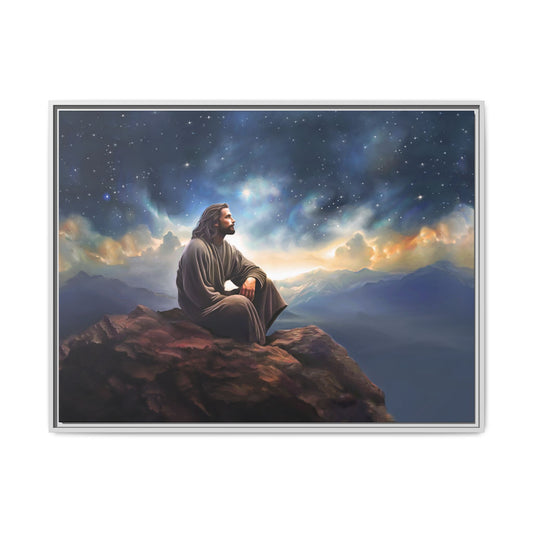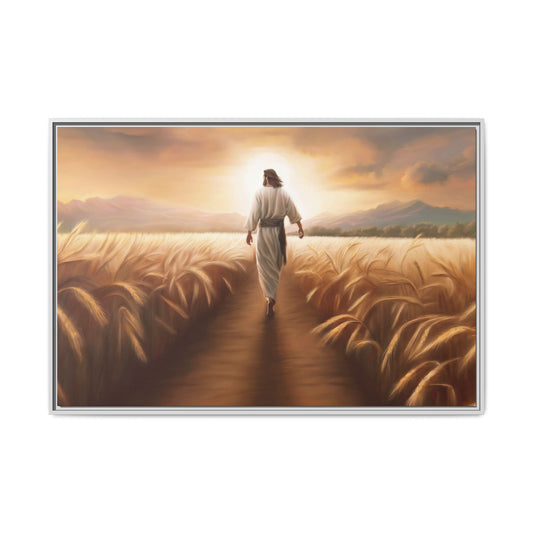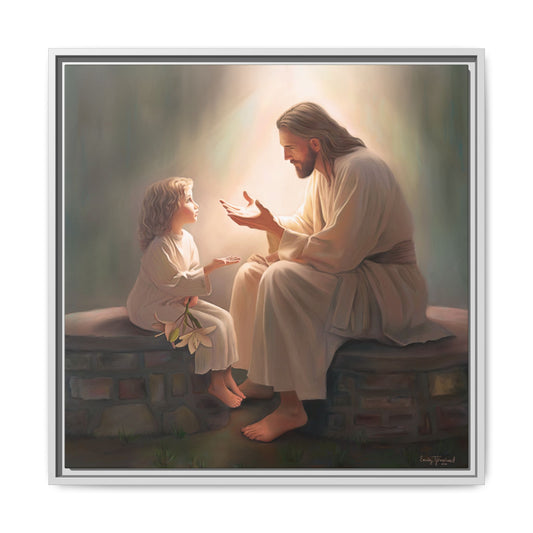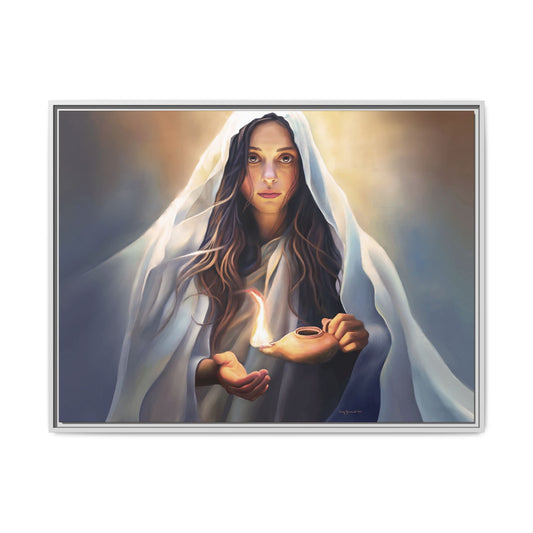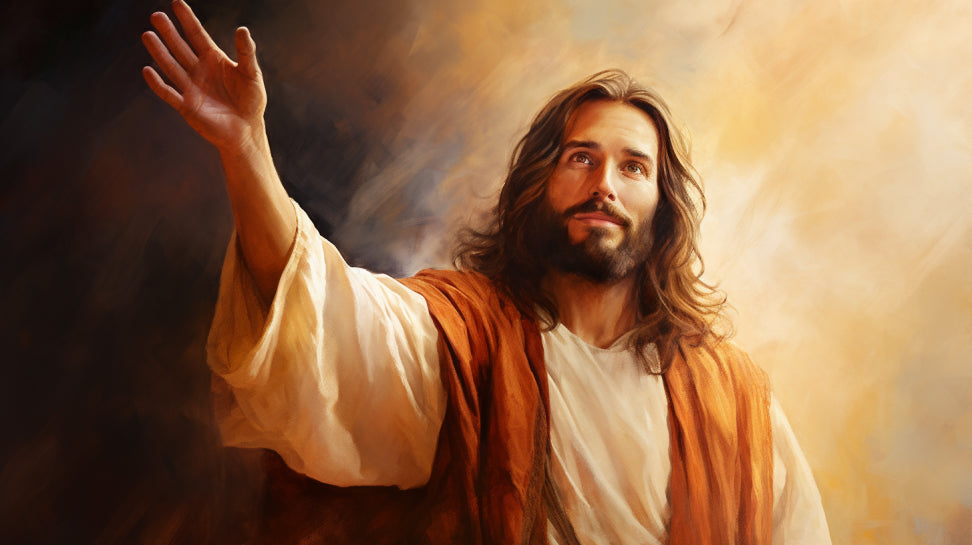
Images of Jesus
Share
As the saying goes, 'a picture is worth a thousand words,' and when it comes to the diverse depictions of Jesus, this adage couldn't be more fitting. The images of Jesus have played a significant role in shaping and reflecting the beliefs and cultures of different communities throughout history. From the earliest portrayals in Christian art to the myriad interpretations in contemporary society, the representations of Jesus have sparked debates, controversies, and profound reflections on identity and faith. Join us as we explore the fascinating historical evolution and the complex layers of meaning behind the images of Jesus, unraveling the power and significance of these visual representations.








Key Takeaways
- Depiction of Jesus in pictorial form can be traced back to early Christian art and architecture.
- The standardized image of a fully bearded Jesus with long hair emerged around AD 300.
- Early Christians had varying opinions on the portrayal of Jesus in images, with some disapproving of such depictions.
- Images of Jesus tend to reflect the ethnic characteristics of the culture in which they were created.

Images of Jesus and the Power of Visual Representations
Visual representations of Jesus have a profound impact on human communication, religious worship, and personal spirituality. The historical significance of Jesus portraits and their role in religious devotion are crucial aspects to consider. People often form deep emotional and spiritual connections with Jesus portraits, making them powerful tools for worship and reflection.The impact of visual images in human communication
The depiction of Jesus in visual images has played a significant role in shaping the communication of religious beliefs and narratives throughout history. Visual images have a profound impact on human communication, as they transcend language barriers and convey powerful messages. The use of images, especially those of religious figures like Jesus, has the ability to evoke strong emotions, convey complex theological concepts, and facilitate a sense of connection with the divine. These images serve as a visual language, enabling individuals to engage with and understand religious teachings in a compelling and accessible manner. Through the centuries, visual representations of Jesus have been instrumental in fostering a deep and enduring connection with believers, allowing for the spread of religious ideas and the portrayal of spiritual narratives through the universal language of imagery.
The historical significance of Jesus Portraits and their role in religious worship
The impact of visual images in human communication has been exemplified through the historical significance of Jesus portraits and their vital role in religious worship, showcasing how visual representations transcend language barriers to convey powerful messages and theological concepts. Images of Jesus hold profound historical significance, serving as a focal point in religious worship, evoking deep emotions, and fostering a sense of connection to the divine. These portraits have played a pivotal role in shaping religious practices, serving as visual aids for prayer, contemplation, and meditation. They serve as a tangible representation of faith and provide a focal point for believers to express devotion and seek spiritual guidance. Through these images, individuals find solace, inspiration, and a sense of unity within their religious communities, reinforcing the profound impact of visual representations in religious worship.The emotional and spiritual connection people often have with Jesus Portraits
Experiencing deep emotional and spiritual connections with Jesus portraits often leads to profound personal revelations and strengthened faith. Many of us find solace and inspiration in visual representations of Jesus, feeling a sense of peace and comfort when gazing upon his compassionate eyes and gentle smile. These portraits serve as a tangible reminder of Jesus' unyielding love and unwavering presence in our lives, evoking feelings of hope, joy, and gratitude. Through these images, we feel a deep sense of connection to Jesus, allowing us to pour out our hearts, seek guidance, and find reassurance in times of need. The emotional and spiritual connection we have with Jesus portraits transcends mere aesthetics, touching the depths of our souls and nurturing our spiritual growth. They foster a profound sense of communion with the divine.
Historical Evolution of Jesus Portraits
Let's start by exploring the earliest depictions of Jesus in art. It's fascinating to consider how different cultures and art movements have influenced the portrayal of Jesus throughout history.An overview of the earliest depictions of Jesus in art
Early Christian art and architecture feature some of the earliest depictions of Jesus, showcasing a diverse range of interpretations before a standardized form emerged in the later centuries. Images of Jesus in early Christian art were more varied before the emergence of a conventional standardized form. The earliest surviving Christian art comes from the late 2nd to early 4th centuries in the catacombs of Rome. Initially, Jesus was represented indirectly through symbols and personified figures. The earliest known portrait of Jesus, found in Syria and dated to about 235, shows him as a beardless young man, depicted with close-cropped hair and wearing a tunic and pallium, similar to Greco-Roman society. This period of diverse depictions highlights the evolving nature of artistic interpretations of Jesus, providing a rich historical context for understanding the development of visual representations of Christ.
Different cultures and art movements influenced the portrayal of Jesus throughout history
Throughout history, different cultures and art movements have significantly influenced the portrayal of Jesus, shaping diverse visual representations of Christ. Art movements such as Byzantine, Renaissance, and Baroque have left their mark on the images of Jesus, each reflecting the cultural and artistic values of their time. The Byzantine style emphasized the divine nature of Jesus, portraying him with a solemn and otherworldly presence. In contrast, the Renaissance period brought a humanistic approach, depicting Jesus with more human-like features and emotions. Furthermore, various cultures around the world have depicted Jesus with their own ethnic characteristics, reflecting the diversity of humanity's interpretation of the Son of God. These cultural and artistic influences have contributed to the rich tapestry of images of Jesus, showcasing the universal appeal and adaptability of his message across different societies and artistic expressions.
Significant Jesus Portraits that have left a lasting impact
The historical evolution of Jesus portraits has been shaped by significant artworks that have left a lasting impact on the visual representation of Christ. These portraits have profoundly influenced the way people perceive the image of Jesus. Some of the most significant portraits include:- The Sallman Head: This portrait by Warner Sallman, created in 1940, became one of the most widely reproduced religious images in the 20th century.
- The Christ of Saint John of the Cross: Painted by Salvador Dali in 1951, this striking portrait of Jesus on the cross has become an iconic representation of the crucifixion.
- The Head of Christ: Another influential portrayal by Warner Sallman, this image, created in 1941, has been widely embraced and reproduced in various forms.
- The Creation of Adam: This iconic fresco painting by Michelangelo, which includes a portrayal of God reaching out to Adam, has influenced countless depictions of Jesus and God in Western art.

Different Types and Styles of Jesus Portraits
Let's talk about the variety of artistic interpretations of Jesus in different art forms, such as paintings and sculptures. There are countless depictions of Jesus throughout history, each with its own unique style and interpretation. Artists have portrayed Jesus in various ways, reflecting their personal beliefs, cultural influences, and artistic techniques. In paintings, Jesus is often depicted with a serene expression, long hair, and a flowing robe, emphasizing his spiritual nature and divine presence. Artists have used different color palettes and composition styles to convey different meanings and emotions. Sculptures of Jesus can range from realistic to abstract, with various materials used, such as marble, bronze, or wood. These sculptures often focus on capturing the physicality of Jesus, showcasing his facial features, body posture, and hand gestures. The symbolism and common elements used in Jesus portraits are also worth exploring. For example, Jesus is often shown with a halo, representing his divine nature and holiness. The presence of other figures, such as angels or disciples, can convey important narratives or theological messages. Furthermore, iconic Jesus portraits hold significant cultural significance. Famous paintings like Leonardo da Vinci's "The Last Supper" or Michelangelo's "The Creation of Adam" have become symbols of Christianity and have influenced how people envision Jesus. These iconic images have been reproduced and referenced in popular culture, religious contexts, and even political movements.
The variety of artistic interpretations of Jesus in different art forms (paintings, sculptures, etc.)
Different cultures and periods have produced a diverse array of artistic interpretations of Jesus in various art forms, such as paintings and sculptures, reflecting the rich and multifaceted nature of Christian iconography. When exploring the image of Jesus in paintings and sculptures, one can appreciate:- Realistic Portrayals: Some artworks depict Jesus with realistic features, aiming to capture a lifelike representation.
- Symbolic Depictions: Artists often utilize symbolism to convey theological concepts and spiritual truths through their interpretations of Jesus.
- Cultural Influences: Different cultures have infused their artistic renditions of Jesus with their own ethnic characteristics, reflecting the diversity of global Christianity.
- Evolution of Styles: Throughout history, the artistic portrayal of Jesus has evolved, demonstrating changes in artistic styles and societal influences.

The symbolism and elements commonly used in Jesus Portraits
Discussing the diverse array of artistic interpretations of Jesus in various art forms, it becomes evident that the symbolism and elements commonly used in Jesus portraits play a significant role in conveying theological concepts and spiritual truths. Images of Jesus often incorporate symbolic elements such as the halo, representing divine light and holiness, and the sacred heart, symbolizing Jesus' love and compassion. The use of specific colors, such as white for purity and red for sacrifice, also holds deep significance in Jesus portraits. Additionally, the portrayal of Jesus in different cultural and ethnic contexts reflects the universal nature of his message. The diverse symbolism and elements in these images serve to deepen our understanding of Jesus Christ and communicate profound spiritual truths, fostering a sense of connection and reverence for the divine in viewers.Iconic Jesus Portraits and their cultural significance
Iconic Jesus portraits hold significant cultural significance, reflecting diverse types and styles that convey profound spiritual truths and universal messages. When exploring these portraits, we can see the rich tapestry of artistic interpretation and cultural influence that has shaped the visual representation of Jesus. Here are some of the different types and styles of Jesus portraits:- Traditional Religious Art: Depictions of Jesus in a classical style, often found in religious settings.
- Renaissance Masterpieces: Iconic paintings by renowned artists, capturing the essence of Jesus in a grand and majestic manner.
- Modern Interpretations: Contemporary artists reimagining Jesus in ways that resonate with today's cultural and social contexts.
- Cultural Variations: Jesus portraits reflecting the ethnic characteristics and artistic traditions of diverse global communities.

Theological and Symbolic Representations in Jesus Portraits
As we consider the theological and symbolic representations in Jesus portraits, it's fascinating to explore the profound significance of these depictions in Christian belief. The symbolism used in these portraits often conveys specific messages or teachings, deepening our understanding of the divine and the teachings of Jesus. Additionally, there are iconic Jesus portraits that carry significant theological meanings, further enriching our exploration of this subject.The theological significance of Jesus Portraits in Christian belief
In Christian belief, Jesus portraits hold deep theological and symbolic significance, reflecting the diverse interpretations and representations of the divine within the faith community. When considering the theological significance of Jesus portraits in Christian belief, we can observe the following aspects:- Representation of Christ: Jesus portraits serve as a visual representation of Christ, embodying the divine attributes and earthly presence of the Lord Jesus.
- Reflection of Cultural Diversity: These portraits often reflect the cultural diversity of the Christian community, showcasing Jesus with various ethnic characteristics based on the cultural context of the artists.
- Spiritual Contemplation: They provide a focal point for spiritual contemplation, allowing believers to meditate on the nature of Christ and deepen their connection to the Lord.
- Historical and Theological Interpretations: Jesus portraits also convey historical and theological interpretations, illustrating how different periods and theological movements have perceived and depicted the figure of Christ.

The symbolism often used in Jesus Portraits to convey specific messages or teachings
The theological significance of Jesus portraits in Christian belief is further illuminated through the symbolic representations used to convey specific messages or teachings, reflecting the multifaceted nature of Christ's portrayal within the Christian tradition. Symbolism in Jesus portraits serves to convey profound theological and spiritual messages, emphasizing the Lord's divinity and teachings. For instance, the use of specific colors, such as white to symbolize purity and red to symbolize sacrifice, communicates the depth of Christ's love and the significance of his redemptive work. Additionally, the inclusion of symbolic elements like the lamb to represent innocence and the shepherd to signify guidance and protection conveys essential aspects of Jesus' teachings and character. These symbolic representations in Jesus portraits encapsulate the profound theological truths and spiritual teachings, enriching the visual portrayal of the Lord.Famous Jesus Portraits that carry significant theological meanings
We explore the theological and symbolic representations found in famous Jesus portraits, and explore their profound meanings and significance within Christian belief and tradition.- The Suffering Christ: Depictions of Jesus on the cross emphasize his sacrifice for humanity, conveying the theological concept of atonement and redemption.
- The Compassionate Savior: Portraits showing Jesus with open arms exemplify his unconditional love and acceptance, reflecting the theological idea of God's compassion and grace.
- The Triumphant King: Images portraying Jesus in regal attire symbolize his sovereignty and authority, reflecting the theological belief in Christ's kingship and lordship.
- The Good Shepherd: Jesus depicted caring for his flock represents the theological concept of Christ as the loving and protective shepherd of his followers, emphasizing the idea of guidance and care within Christian theology.
Controversies Surrounding Jesus Portraits
We've come across historical debates and controversies linked to the portrayal of Jesus in art, which have sparked fervent discussions and debates. Cultural and racial representations of Jesus have played a significant role in shaping religious discourse and remain a topic of intense interest. The impact of controversial Jesus portraits is evident in the way they've influenced beliefs and perceptions, making this a crucial area of exploration in the context of religious and artistic expression.Historical debates and controversies related to the portrayal of Jesus in art
During the early period of Christianity, controversies and debates arose surrounding the portrayal of Jesus in art, reflecting diverse opinions and theological perspectives within the Christian community.- Some early Christian writers disapproved of portrayals of Jesus in images.
- The issue of depicting Jesus remained controversial until the end of the 4th century.
- The Synod of Elvira in Spain in 306 AD stated that no images should be in churches.
- In the 16th-century Protestant Reformation, images of Christ were seen as idolatrous by followers of John Calvin.
Cultural and racial representations of Jesus have sparked discussions and debates
Cultural and racial representations of Jesus have sparked discussions and debates, highlighting the diverse perspectives within the Christian community. The cultural and racial depictions of Jesus in art have been a source of controversy and debate. Different cultures have portrayed Jesus with their own ethnic characteristics, leading to questions about the historical accuracy and the impact of these representations. The belief in historically authentic or authoritative images of Jesus remains strong in some Christian traditions, while others argue for a more universal and inclusive portrayal. These discussions have prompted a reevaluation of the visual representations of Jesus and their cultural implications. As a community, we're called to engage in respectful conversations about the cultural and racial aspects of Jesus' depictions, seeking to understand and serve one another in love.The impact of controversial Jesus Portraits and their role in shaping religious discourse
The controversies surrounding cultural and racial representations of Jesus have prompted a reevaluation of the visual depictions of Jesus and their impact on religious discourse. These controversial Jesus portraits have played a significant role in shaping religious conversations and perspectives. Cultural Impact: Controversial portraits have sparked discussions about the cultural and ethnic characteristics depicted in images of Jesus. Religious Discourse: These portraits have influenced theological conversations and beliefs within the Christian community. Historical Significance: The controversies surrounding Jesus portraits have historical implications, dating back to early Christian art and architecture. Role in Worship: The impact of controversial Jesus portraits extends to their role in worship practices and the sacredness attributed to these depictions. The influence of these portraits on the perception of the holy and the Christian faith can't be understated, as they continue to shape religious discourse and beliefs.Jesus Portraits and Worship
Jesus Portraits play a crucial role in our worship experiences, both in church settings and in personal prayer spaces. These images have the power to enhance our connection with God and deepen our spiritual experience. It's fascinating to explore the diverse ways in which Jesus Portraits are utilized in worship practices across different cultures and traditions.The role of Jesus Portraits in worship settings, such as churches and personal prayer spaces
Portraits of Jesus play a significant role in shaping the worship experience for believers in churches and personal prayer spaces. They serve as visual aids that evoke reverence and deepen spiritual connection. In worship settings, such as churches and personal prayer spaces, Jesus portraits fulfill several important roles:- Symbolism: Jesus portraits symbolize the presence of Christ in the midst of worship, reminding believers of His teachings and sacrifice.
- Inspiration: They inspire contemplation, prayer, and a sense of awe, fostering a deeper connection with the divine during worship.
- Focus: Jesus portraits help believers focus their thoughts and emotions during prayer, creating a sacred atmosphere conducive to worship.
- Unity: They serve as a unifying element, drawing individuals together in communal worship, reinforcing the sense of belonging to a larger spiritual family.
How Jesus Portraits can enhance the worship experience and foster a deeper connection with God
Incorporating Jesus portraits into worship spaces enhances the spiritual atmosphere and deepens believers' connection with God. When we gather for worship, the visual representation of Jesus can serve as a focal point for our prayers and reflections, helping us to center our hearts and minds on His presence. The act of gazing upon a portrait of Jesus can evoke a sense of reverence and awe, leading us into a deeper worship experience. As we contemplate the compassionate eyes and gentle expression of Jesus in these portraits, we're reminded of His unconditional love and grace, nurturing a profound connection with our Savior. These portraits serve as a powerful reminder of the living presence of Christ among us, enriching our prayer life and fostering a deeper communion with God.Examples of how Jesus Portraits have been used in worship practices around the world
Enhancing the worship experience and fostering a deeper connection with God, Jesus portraits have been utilized in worship practices around the world to create a focal point for prayers and reflections, aiding in centering hearts and minds on His presence. Here are some examples of how Jesus portraits have been used in worship practices around the world:- Adorning church walls and altars, serving as a visual representation of Christ during worship services.
- Being used as focal points for meditation and prayer in individual or communal worship settings.
- Inspiring artistic expressions of devotion, such as paintings, sculptures, and stained glass windows in various cultural and religious contexts.
- Playing a central role in processions, rituals, and ceremonies, symbolizing the presence and significance of Jesus in the worship of diverse Christian communities worldwide.
Collecting and Appreciating Jesus Portraits
As we explore the subtopic of 'Collecting and Appreciating Jesus Portraits,' we come across valuable tips for those interested in gathering these portraits. Owning and appreciating Jesus Portraits not only adds aesthetic value to our surroundings but also serves as expressions of our faith. Renowned artists have created exceptional Jesus Portraits, making it a fascinating journey to appreciate and collect these pieces of art.Tips for individuals interested in collecting Jesus Portraits
Collecting and appreciating Jesus portraits can be a rewarding and enriching experience for individuals seeking to explore the diverse depictions of Jesus in different cultures and historical periods. Here are some tips for those interested in starting a collection:- Research: Learn about the different cultural and historical representations of Jesus to understand the variety of depictions available.
- Visit Art Exhibits and Museums: Explore art galleries and museums to view a wide range of Jesus portraits and gain a deeper appreciation for the diversity of artistic interpretations.
- Connect with Collectors: Join communities or online forums of art collectors to learn from experienced individuals and share insights about acquiring and appreciating Jesus portraits.
- Consider the Meaning: Reflect on the significance of each portrait and how it resonates with your personal beliefs and spiritual journey.
The value of owning and appreciating Jesus Portraits as pieces of art and expressions of faith
Owning and appreciating Jesus Portraits as pieces of art and expressions of faith adds depth and beauty to our spiritual journey. Each portrait serves as a visual reminder of Jesus' teachings and the love He embodies. These pieces of art have the power to evoke a sense of peace, hope, and connection to our faith. They become focal points for prayer, meditation, and reflection, enriching our daily spiritual practices. Furthermore, they serve as conversation starters, allowing us to share our faith with others. As we appreciate the intricate details and emotions captured in each portrait, it deepens our understanding of Jesus' life and mission. Through these portraits, we feel a tangible representation of our faith, strengthening our bond with Jesus and the beliefs we hold dear.Renowned artists known for creating exceptional Jesus Portraits
Renowned artists known for creating exceptional Jesus portraits stand out due to their profound ability to capture the essence of Jesus through their art. The following features characterize their work:- Mastery of Technique: These artists possess exceptional skill and expertise in painting, sculpting, or other artistic mediums, enabling them to create lifelike and emotionally evocative representations of Jesus.
- Deep Spiritual Insight: Their work reflects a deep understanding of Jesus' life, teachings, and spiritual significance, conveying profound messages of faith and divine love.
- Emotional Impact: Renowned artists elicit strong emotional responses through their portraits, stirring feelings of reverence, compassion, and inspiration in viewers.
- Enduring Legacy: Their exceptional Jesus portraits leave a lasting impact, transcending time and cultural boundaries, and continue to inspire and resonate with individuals across generations and diverse backgrounds.
Jesus Portraits as tools for worship and expressions of faith
We all can find meaning and inspiration in Jesus portraits as tools for worship and expressions of faith. The beauty and spirituality found in these images can help us connect with the divine and deepen our religious experiences.We can all learn to appreciate the beauty and spirituality found in Jesus Portraits
Appreciating the beauty and spirituality found in Jesus Portraits enhances our worship experience and serves as a profound expression of our faith. When we take the time to appreciate Jesus Portraits, we connect with the spiritual significance they hold and deepen our understanding of our faith. To truly appreciate the beauty and spirituality found in Jesus Portraits, we can:- Reflect on the emotions and messages conveyed through the artwork.
- Use the portraits as focal points for meditation and prayer.
- Incorporate Jesus Portraits into our worship spaces to create an atmosphere of reverence and devotion.
- Share our love for Jesus Portraits with others, spreading the beauty and spirituality they represent.

